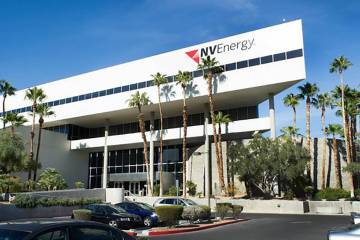Supporters of maglev see chance to re-enter game
As the XpressWest and X Train passenger rail projects look to regroup, supporters of Southern Nevada’s original high-speed plan — the maglev — are seeing an opportunity to re-enter the game.
Bruce Aguilera, an attorney with MGM Resorts International’s Bellagio and CityCenter properties and former chairman of the California-Nevada Super Speed Train Commission, said the stops and starts of the XpressWest and X Train projects have opened the door to reconsideration of maglev, especially since the technology has improved over the years and its cost has dropped.
Aguilera, who had to step down from the train commission after accepting an appointment to the Nevada Taxicab Authority earlier this year, said the need for high-speed transportation between Southern California and Las Vegas has never gone away. The traffic jams on Interstate 15, especially on the Fridays and Mondays of three-day weekends, are a drag on Southern Nevada’s tourism economy and are a danger to motorists.
“It’s a lot easier to convince people that this is a tried-and-true technology,” Aguilera said of maglev.
Maglev technology is propulsion over a magnetic field on a cushion of air above a guideway. Maglev vehicles can travel up to 300 mph.
A maglev has been operating between the Shanghai airport and its city center for more than a decade. A German company has perfected maglev technology over the years, and Japanese transportation leaders who brought the bullet train to market are shifting their attention to maglev.
“The only moving parts on the train are the doors,” Aguilera said.
He said although the cost of maglev is slightly higher than traditional steel wheels on rail, the maintenance costs are lower because there are no friction points between the vehicle and the track. The guideways are sturdier and last longer than rails and among the innovations are the ability to use the guideways to convey electricity. Maglev guideways also can be used as long linear solar collectors because each guideway is activated only when a train passes over it.
Attorney Neil Cummings heads the American Magline Group, the company that is collaborating with the California-Nevada Super Speed Train Commission.
Maglev supporters once were looking to build a line from Anaheim, Calif., to Las Vegas along I-15. Unlike high-speed rail technology, maglev would be able to climb the steep Cajon Pass grade.
Initially, the maglev proposal included building the first 40 miles of the line from Las Vegas to Primm as a demonstration of the technology and a tourist attraction.
It would also have doubled as a link to where Las Vegas once was considering a reliever airport in the Ivanpah Valley. The need for a new airport has eased with the opening of McCarran International Airport’s Terminal 3 and Sen. Harry Reid’s switch in support from maglev to conventional high-speed rail all but killed any chance for the maglev to be built in Nevada.
But Cummings remains optimistic and has a collection of municipalities along I-15 and California Highway 91 that support building a maglev line between the new Anaheim Regional Transportation Intermodal Center and Ontario International Airport, a large inland reliever airport for air traffic at Los Angeles International, Burbank and Long Beach.
An Anaheim-to-Ontario maglev would zip travelers past freeway traffic jams in minutes.
Cummings believes it will take political muscle in Nevada to get Las Vegas back into the rail conversation. He noted that Las Vegas once was believed to be the first place that Americans would see high-speed transportation as good as anything found in Europe or Asia.
Now, it’s at the bottom of the heap with no solid plan for a train of any kind.
Contact reporter Richard N. Velotta at rvelotta@reviewjournal.com or 702-477-3893. Follow @RickVelotta on Twitter.

















